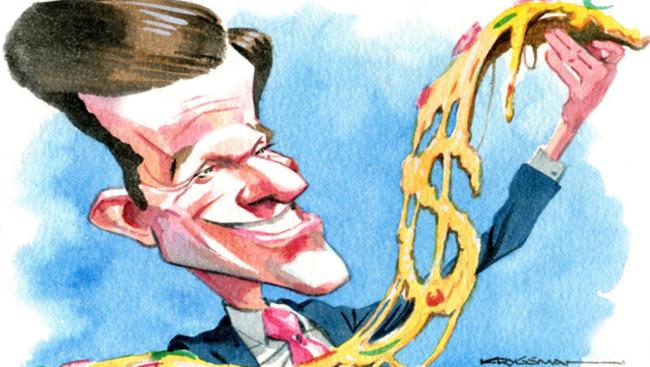Saputo’s takeover bid for Murray Goulburn faces regulatory hurdles
Lino Saputo is charming farmers around Victoria, but his $1.3bn deal to buy Murray Goulburn has hurdles to clear.

Lino Saputo is charming farmers around Victoria, but the reality is his $1.3 billion deal to buy Murray Goulburn has some hurdles to clear.
The ACCC will provide some guidance in the next fortnight when it releases its interim report on the dairy industry.
The report will focus on the value chain in the industry from farm supplier to supermarket and where the power lies and how it is expressed.
Four years ago, when Saputo acquired Warrnambool Cheese & Butter, he was helped by the fact the ACCC was perceived to be opposing Murray Goulburn’s alternative bid.
Now Saputo owns WCB the argument Lino uses is the industry has changed so much, as shown by the fact MG’s milk intake has fallen from 3.5 billion litres a year to 2.5 billion.
There is clearly competition at supplier level, but the ACCC concern was based on the simple fact there were three competing suppliers including Fonterra and with MG buying WCB there would only be two.
That’s exactly what happens with Saputo buying MG, and maybe if Bega or the Chinese were allowed in the tent then there would still be three suppliers chasing the farmers.
The ACCC would have the answer in February and this month’s interim dairy report should provide some clues.
While all this intrigue is happening on this side of the Tasman, Saputo travelled to Christchurch last weekend to visit, among other people, former staffer Tony McKenna who now runs Bosco Dairy in New Zealand.
Saputo declined to comment on who else he visited, but one suggestion is New Zealand’s second biggest co-op, Westland Milk which, like MG, has seen better days financially.
Saputo played down suggested talks with infant milk provider Synlait and noted he could not deal with the MG assets until the deal closes sometime after February next year, which is why all fingers point to a potential Westland conversation.
Maybe the Canadian will add a New Zealand co-op to his down under dairy assets.
Dairy farmers contacted speak highly about his diligence in his visits here, noting access to Saputo management was way ahead of MG. Saputo did confide he had very limited due diligence on the MG deal with no access to debt holders or supplier contracts, which of course was an issue that seemed to trouble others more than it did him.
MG is pressing ahead with a rumoured sale of its Edith Creek plant in Tasmania with Thai-based Dutch Mill a rumoured buyer.
In the meantime, while Saputo says the Mark Elliott class action is MG’s problem, it may be his if it is left to run and arguably some certainty would be gained by an early settlement.
Before any Westland deal, the MG acquisition would boost Australia to 25 per cent of Saputo’s global assets and on par with his home base at Canada where he ranks as the biggest mozzarella supplier.
Heat over long life milk
Four months ago, Chinese authorities shut down supplies from Parmalat’s Clarence Gardens long life milk plant over a dispute over the temperature used to prepare the product.
Parmalat was producing the product on behalf of the South Australian Dairy Association and faced no questions about the temperature issues just over a year ago. The problem emerged back in July when Bellamy’s had issues with one of its plants in Victoria, but this has since been sorted out.
Not so for Parmalat, and the issue, while not huge in terms of the volume of product affected, is of concern because the Chinese market is worth in excess of $20 million to the local arm of the Italian-based giant.
It is also obviously a market it would like to grow, Chinese authorities willing.
Wage growth woes
It is hard not to draw negative conclusions as yesterday’s wages figures show just a 0.5 per cent increase in the September quarter and 2 per cent over the last year.
Coles boss John Durkan for one has been banging the drum that a significant proportion of his customers have been getting zero increases in pay yet at the same time had to find money to pay for the 58 per cent increase in childcare costs and huge increases in utility costs.
The numbers tell you, as if we didn’t know already, the chances of any increase in interest rates next May are almost zero, and at best — or worst, depending on where you sit — there will only be one rate hike next calendar year.
This week’s NAB business conditions survey once again highlighted a split between business conditions, what businesses are actually doing and confidence, with the latter minimal in part due to concern at the turmoil in Canberra.
If ever Malcolm Turnbull needs to show some leadership on the same-sex marriage vote then it is now in the wake of yesterday’s poll result.
The bearish view on the economy expressed by Westpac et al is that, with minimal wages growth and the peak of the housing cycle in the past, next year looks worse.
The bullish view exposed by Saul Eslake, NAB et al is that business activity is slowly picking up around the world and this will drive income momentum.
There is evidence this is true in the US and maybe the bottom line is the unemployment rate has to fall further from 5.5 per cent to mark the start of wages growth.
Colourful record
Patrick Houlihan has Dulux running like a well-oiled machine, which is reflected in the 37 per cent returns he earns in the business and the 4.6 per cent increase in his stock price to an all-time high of $7.89 a share.
No wonder that after 10 years running the business, and seven as a separately listed company, he has no plans on moving on anytime soon.
The Dulux paint business is seemingly impervious to economic cycles and accounts for 77 per cent of group earnings with impressive margins of 17.6 per cent.
The paint brand is owned outside this region by Dutch-based Akzo Nobel, but Houlihan runs the Selleys brand globally and is taking this into new markets like Indonesia.
The local competitors are two US-based multinationals PPG, which owns Taubmans and Sherwin Williams, which owns Valspar among others.
Dulux has about 47 per cent of the retail market.
He has followed his friends from Bunnings into Britain with Selleys and the Craig & Rose brand and reports strong support in the new Bunnings stores.
The problem with the Homebase stores in Britain it seems is Wesfarmers made too many changes, which has put off the loyal British shopper without attracting new ones. Which is why the plan is to quicken the rollout of Bunnings, but in such a way that it doesn’t repeat the Woolworths debacle at Masters by continuing to flog a dead horse.
Hopefully the horse will be alive and well.
Dulux’s international brands only accounts for 4 per cent of sales and the company seems set to abandon the China paint market where the DGL Camel joint venture is struggling.
At this stage the business is simply listed as under review.
It has gone OK in Hong Kong, but the push into the mainland has found little support.
It seems Selley’s has brighter prospects.
The Warrnambool-educated Houlihan is taking things carefully offshore with earnings of just $11.3m on sales of $222.2m, out of group earnings of $214.2m and sales of $1.8bn.
Houlihan frames the company as primarily a marketing vehicle, and with 130 scientists and 140 marketers that means innovation, brand strength and selling skills.
A planned upgrade with a new paint factory in Melbourne will open on schedule next year and the China issue aside Houlihan has the company performing well.




To join the conversation, please log in. Don't have an account? Register
Join the conversation, you are commenting as Logout